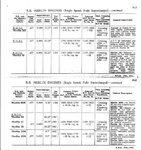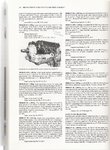So, i'm little "in the ware" when talking about the Merlins,
so i made a list and hope someone could correct the power/altitude and even maybe add some info, maybe some Power-vs-Alt charts, that are afwul difficult to find.
Let's start with the M45 family:
Merlin 45
-3038 airframes equipped
-used in Spitfire Mk.V
-carburator with shilling orifice
- 1,515 hp (1,130 kW) at 3,000 rpm at 11,000 ft (3,353 m)
---------------------------------------------------------
Merlin 45M
- Cropped version?Alt? Power?boost?
- 266 airframes equipped, mostly LF-LR-Vb
.-carburator with shilling orifice
-no info
---------------------------------------------------------
Merlin 46
-3244 airframes equipped
-high-altitude version used in Spitfire PR.Mk.IV(T),seafire IIc,Seafire LIIc,SpitVb,SpitVbT,SpitVc,SpitVcT-
-1,415 hp (1,055 kW) at 3,000 rpm at 14,000 ft (4,270 m)
-Carb with shiling device?
-------------------------------------------------------------
Merlin 50
-503 airframes equipped-Seafire IIc,Spit Vc and mostly SpitVcT
-no info what difference with M45-M46?
--------------------------------------------------------------
Merlin 50M (not in the spit production list!different name?)
- 1,585 hp (1,182 kW) at 3,000 rpm at 2,750 ft (838 m);
- Low altitude version with supercharger impeller "cropped" to 9.5 inches (240 mm) in diameter.
- Permitted boost was +18 lb/sq.in. instead of +16 lb/sq.in. as on a normal Merlin 50 engine.
- A "negative g" carburettor was fitted.(shiling orifice?New carb?)
------------------------------------------------------------------
Merlin 55
- 1256 airframes equipped-Seafire III,Spit Vc,SpitVcT
-no info
------------------------------------------------------------------
Merlin 61
-575 airframes equipped-mostly First batch of MkIX plus few PRXI,SpitMkVII+MkVIII
-fitted with a new two-speed two-stage supercharger providing 1,565 hp (1,170 kW) at 3,000 rpm at 12,250 ft (3,740 m), and 1,390 hp (1,035 kW) at 3,000 rpm 23,500 ft (7,170 m)
-high-altitude version
-Carb with shilling orifice? (G-neg sensitive)
--------------------------------------------------------------------
Thanks for your help
so i made a list and hope someone could correct the power/altitude and even maybe add some info, maybe some Power-vs-Alt charts, that are afwul difficult to find.
Let's start with the M45 family:
Merlin 45
-3038 airframes equipped
-used in Spitfire Mk.V
-carburator with shilling orifice
- 1,515 hp (1,130 kW) at 3,000 rpm at 11,000 ft (3,353 m)
---------------------------------------------------------
Merlin 45M
- Cropped version?Alt? Power?boost?
- 266 airframes equipped, mostly LF-LR-Vb
.-carburator with shilling orifice
-no info
---------------------------------------------------------
Merlin 46
-3244 airframes equipped
-high-altitude version used in Spitfire PR.Mk.IV(T),seafire IIc,Seafire LIIc,SpitVb,SpitVbT,SpitVc,SpitVcT-
-1,415 hp (1,055 kW) at 3,000 rpm at 14,000 ft (4,270 m)
-Carb with shiling device?
-------------------------------------------------------------
Merlin 50
-503 airframes equipped-Seafire IIc,Spit Vc and mostly SpitVcT
-no info what difference with M45-M46?
--------------------------------------------------------------
Merlin 50M (not in the spit production list!different name?)
- 1,585 hp (1,182 kW) at 3,000 rpm at 2,750 ft (838 m);
- Low altitude version with supercharger impeller "cropped" to 9.5 inches (240 mm) in diameter.
- Permitted boost was +18 lb/sq.in. instead of +16 lb/sq.in. as on a normal Merlin 50 engine.
- A "negative g" carburettor was fitted.(shiling orifice?New carb?)
------------------------------------------------------------------
Merlin 55
- 1256 airframes equipped-Seafire III,Spit Vc,SpitVcT
-no info
------------------------------------------------------------------
Merlin 61
-575 airframes equipped-mostly First batch of MkIX plus few PRXI,SpitMkVII+MkVIII
-fitted with a new two-speed two-stage supercharger providing 1,565 hp (1,170 kW) at 3,000 rpm at 12,250 ft (3,740 m), and 1,390 hp (1,035 kW) at 3,000 rpm 23,500 ft (7,170 m)
-high-altitude version
-Carb with shilling orifice? (G-neg sensitive)
--------------------------------------------------------------------
Thanks for your help






